Catalysts for the Conversion of CO2 to Low Molecular Weight Olefins—A Review
Abstract
:1. Introduction
2. Reaction Mechanism
2.1. Modified Fischer–Tropsch to Olefins (FTO)
2.2. Methanol-Mediated Olefin Synthesis (MTO)
3. Dynamic Character of the Catalytically Active Iron Phases
4. Promotion of Fe-Based Catalysts
4.1. Promotion with Co
4.2. Promotion with Alkali Metals
4.3. Promotion with Mn
4.4. Others Promotors
5. Tandem Catalytic Systems
5.1. Carbon-Based Catalysts
| Catalyst | T (°C) | P (MPa) | H2/CO2 Ratio | Conversion (%) | Yield c C2–C4= | Ref. |
|---|---|---|---|---|---|---|
| Alkali—Fe carbide | 270 | 1.2 | 3 | 25.5 | 8.5 | [67] |
| 5%NaFe | 290 | 1.5 | 3 | 34.7 | 18.8 | [66] |
| K–Fe–Al–O (nanobelts) | 300 | 1 | 4 | 48.0 | 25.0 | [125] |
| K–Fe–Co/Al2O3 | 300 | 1.1 | 3 | 31.0 | 17.9 | [51] |
| In2O3/ZrO2+SAPO-34 | 400 | 1.5 | 3 | 19.0 | 16.2 | [8] |
| Fe–Co/K–Al2O3 | 320 | 2 | 3 | 49.0 | 18.1 | [107] |
| Fe3O4 (microsphers) | 350 | 2 | 3 | 43.0 | 15.7 | [78] |
| 10Mn–Fe3O4 (microspheres) | 350 | 2 | 3 | 44.7 | 18.7 | [78] |
| M–InS/Fe–Co | 360 | 2 | 3 | 50.9 | 11.5 | [106] |
| T–InS/B–FeCo | 360 | 2 | 3 | 48.0 | 21.5 | [106] |
| T–FeCo/B–InS | 360 | 2 | 3 | 47.7 | 16.2 | [106] |
| NiCu/CeO2–SAPO-34 | 375 | 2 | 3 | 15.3 | 11.7 | [88] |
| 13%ZnO–ZrO2/MnSAPO-34 | 380 | 2 | n/a b | 21.3 | 13.1 | [126] |
| ZnO–ZrO2/SAPO-34 | 380 | 2 | 3 | 12.6 | 10.1 | [40] |
| 0.5%NaFe | 320 | 3 | 3 | 38.4 | 24.7 | [63] |
| Mn/Na/Fe | 320 | 3 | 3 | 38.6 | 11.7 | [62] |
| ZnGa2O4/SAPO-34 | 370 | 3 | 3 | 13.0 | 11.2 | [102] |
| MgGa2O4/SAPO-34 | 370 | 3 | 3 | 8.7 | 1.0 | [102] |
| ZnGa2O4/SAPO-34 | 370 | 3 | 3 | 13.0 | 6.0 | [62] |
| ZnAl2O4/SAPO-34 | 370 | 3 | 3 | 15.0 | 6.7 | [102] |
| In–Zr(4:1)/SAPO-34 | 380 | 3 | 3 | 26.2 | 19.5 | [97] |
| K–Fe–Co–Zr fibers | 400 | 3 | 3 | 42.0 | 12.6 | [58] |
5.2. Effect of the Catalyst Preparation Method
5.3. New Strategies of the Catalyst Preparation
6. Conclusions
- Despite major advances in catalyst design, the selectivity towards short-chain olefins remains unsatisfactory. In this regard, it is necessary to solve the general problem of olefins desorption. In order to improve olefin formation, it is necessary to modify the functionality of the catalyst by adjusting the strength of the metal–H and metal–C bonds, improving the localization of the active phases, the basicity of the catalyst, the morphology of the support, etc.;
- Iron-based catalysts remain the most widely used catalysts for the production of light olefins via CO2 hydrogenation due to their optimal activity/cost ratio. However, although these catalysts were studied for decades, the genesis, the exact nature of the active site and the reaction mechanism under real reaction conditions remain unclear. This is mainly due to the absence of effective in situ characterization techniques and the dynamic changes in the iron phases during the course of the reaction. In this regard, it is necessary to combine experimental work and theoretical study at the molecular level to elucidate the reaction mechanisms in catalysts operating via the FTO and MTO reaction pathways;
- Since the activity and stability of iron catalysts are dramatically increased by incorporating suitable promoters, it is necessary to elucidate the promoter mechanisms to accommodate promoter elements in well-defined and tailored sites to design promoted catalysts capable of producing olefins by the direct CO2 hydrogenation route;
- The general problems of catalyst deactivation produced by CO and H2O need to be solved. Promising strategies for the improvement of catalyst stability should be the confinement of the active phases within the internal structure of the zeolite or the preparation of catalysts with a core-shell structure. However, the preparation of these catalysts requires very complicated procedures, which increases the cost of the catalyst. In order to decrease the deactivation of the catalyst by H2O, tandem catalysts with higher hydrophobicity should be designed;
- Finally, for the direct formation of olefins from CO2, new promoted and multifunctional catalysts are expected to be developed, while iron-based catalysts need to be optimized. Among the alternative formulations to iron catalytic systems, those based on In2O3 have sufficient potential to overcome the limitations observed in conventional iron catalysts. In order to reduce poisoning by the CO product, promising results showed tandem catalysts with metal oxide In2O3/ZrO2 and zeolite SAPO-34 components. Catalysts with a shell-like structure or nanobelts/nanofiber morphology provide good contact between the active phases. However, their complex preparation methods limit their large-scale use for industrial purposes.
Author Contributions
Funding
Institutional Review Board Statement
Informed Consent Statement
Data Availability Statement
Acknowledgments
Conflicts of Interest
References
- González-Carballo, J.M.; Fierro, J.L.G. Fundaments of syngas production and Fischer-Tropsch Synthesis. In Biofuels from Fischer-Tropsch Synthesis; Ojeda, M., Rojas, S., Eds.; Energy Science, Engineering and Technology, Nova. Sci. Pub. Inc.: New York, NY, USA, 2010; ISBN 978-1-61668-366-5. [Google Scholar]
- Song, C. Global challenges and strategies for control, conversion and utilization of CO2 for sustainable development involving energy, catalysis, adsorption and chemical processing. Catal. Today 2006, 115, 2–32. [Google Scholar] [CrossRef]
- Ma, Z.; Porosoff, M.D. Development of tandem catalysts for CO2 hydrogenation to olefins. ACS Catal. 2019, 9, 2639–2656. [Google Scholar] [CrossRef]
- Ronda-Llioret, M.; Rothenberg, G.; Shiju, N.R. A critical look at direct catalytic hydrogenation of carbon dioxide to olefin. ChemSusChem 2019, 12, 3896–3914. [Google Scholar] [CrossRef] [PubMed]
- NASA Global Climate Change, Carbon Dioxide. 2021. Available online: https://climate.nasa.gov/vital-signs/carbon-dioxide (accessed on 16 November 2021).
- Centi, G.; Quadrelli, E.A.; Perathoner, S. Catalysis for CO2 conversion: A key technology for rapid introduction of renewable energy in the value chain of chemical industries. Energy Environ. Sci. 2013, 6, 1711–1731. [Google Scholar] [CrossRef]
- Gao, Y.; Liu, S.; Zhao, Z.; Tao, Z.; Sun, Z. Heterogeneous catalysis of CO2 hydrogenation to C2+ products. Acta Phys.-Chim. Sin. 2018, 34, 858–872. [Google Scholar] [CrossRef]
- Gao, J.; Jia, C.; Liu, B. Direct and selective hydrogenation of CO2 to ethylene and propene by bifunctional catalysts. Catal. Sci. Technol. 2017, 7, 5602–5607. [Google Scholar] [CrossRef]
- Al-Dossary, A.; Fierro, J.L.G. Effect of high-temperature pre-reduction in Fischer–Tropsch synthesis on Fe/ZrO2 catalysts. Appl. Catal. A Gen. 2015, 499, 109–117. [Google Scholar] [CrossRef]
- Hamilton, N.G.; Warringham, R.; Silverwood, I.P.; Kapitán, J.; Hecht, L.; Webb, P.B.; Tooze, R.P.; Zhou, W.; Frost, C.D.; Parker, S.F.; et al. The application of inelastic neutron scattering to investigate CO hydrogenation over an iron Fischer-Tropsch synthesis catalyst. J. Catal. 2014, 312, 221–231. [Google Scholar] [CrossRef] [Green Version]
- Lu, J.; Yang, L.; Xu, B.; Wu, Q.; Zhang, D.; Yuan, S.; Zhai, Y.; Wang, X.; Fan, Y.; Hu, Z. Promotion effects of nitrogen doping into carbon nanotubes on supported iron Fischer-Tropsch catalysts for lower olefins. ACS Catal. 2014, 4, 613–621. [Google Scholar] [CrossRef]
- Saedi, S.; Amin, N.A.S.; Rahimpour, M.R. Hydrogenation of CO2 to value-added products—A review and potential future developments. J. CO2 Util. 2014, 5, 66–81. [Google Scholar] [CrossRef]
- Guo, L.; Sun, J.; Ge, Q.; Tsubaki, N. Recent advances in direct catalytic hydrogenation of carbon dioxide to valuable C2+ hydrocarbons. J. Mater. Chem. A 2018, 6, 23244–23262. [Google Scholar] [CrossRef]
- Zhou, W.; Cheng, K.; Kang, J.; Zhou, C.; Subramanian, V.; Zhang, Q.; Wang, Y. New horizon in C1 chemistry: Breaking the selectivity limitation in transformation of syngas and hydrogenation of CO2 into hydrocarbon chemical and fuels. Chem. Soc. Rev. 2019, 48, 3193–3228. [Google Scholar] [CrossRef]
- Zhang, C.; Zhang, Y.; Zhu, M.; Meng, B.; Tu, W.; Han, Y. New pathway for CO2 high-valued utilization: Fe based catalysts for CO2 hydrogenation to low olefins. Chem. Ind. Eng. Prog. 2021, 40, 577–593. [Google Scholar] [CrossRef]
- Yang, H.Y.; Zhang, C.; Gao, P.; Wang, H.; Li, X.P.; Zhong, L.S.; Wei, W.; Sun, Y.H. A review of the catalytic hydrogenation of carbon dioxide into value-added hydrocarbons. Catal. Sci. Technol. 2017, 7, 4580–4598. [Google Scholar] [CrossRef]
- Ojelade, O.A.; Zaman, S.F. A review on CO2 hydrogenation to lower olefins: Understanding the structure-property relationships in heterogeneous catalytic systems. J. CO2 Util. 2021, 47, 101506. [Google Scholar] [CrossRef]
- Numpilai, T.; Cheng, C.K.; Limtrakul, J.; Witoon, T. Recent advances in light olefins production from catalytic hydrogenation of carbon dioxide. Process. Saf. Environ. Prot. 2021, 151, 401–427. [Google Scholar] [CrossRef]
- Al-Dossary, M.; Ismail, A.A.; Fierro, J.L.G.; Bouzid, H.; Al-Sayari, S.A. Effect of Mn loading onto MnFeO nanocomposites for the CO2 hydrogenation reaction. Appl. Catal. B Environ. 2015, 165, 651–660. [Google Scholar] [CrossRef]
- Herranz, T.; Rojas, S.; Ojeda, M.; Pérez-Alonso, F.J.; Terreros, P.; Pirota, K.; Fierro, J.L.G. Synthesis, structural features, and reactivity of Fe-Mn mixed oxides prepared by microemulsion. Chem. Mater. 2006, 18, 2364–2375. [Google Scholar] [CrossRef]
- Herranz, T.; Rojas, S.; Pérez-Alonso, F.J.; Ojeda, M.; Terreros, P.; Fierro, J.L.G. Hydrogenation of carbon oxides over promoted Fe-Mn catalysts prepared by the microemulsion methodology. Appl. Catal. A Gen. 2006, 311, 66–75. [Google Scholar] [CrossRef]
- Pérez-Alonso, F.J.; Herranz, T.; Rojas, S.; Granados, M.L.; Ojeda, M.; Terreros, P.; Fierro, J.L.G.; Gracia, M.; Gancedo, J.R. Evolution of the bulk structure and surface species on Fe–Ce catalysts during the Fischer–Tropsch synthesis. Green Chem. 2007, 9, 663–670. [Google Scholar] [CrossRef]
- Pérez-Alonso, F.J.; López Granados, M.; Ojeda, M.; Terreros, P.; Rojas, S.; Herranz, T.; Fierro, J.L.G.; Gracia, M.; Gancedo, J.R. Chemical structures of coprecipitated Fe−Ce mixed oxides. Chem. Mater. 2005, 17, 2329–2339. [Google Scholar] [CrossRef]
- Pérez-Alonso, F.J.; Ojeda, M.; Herranz, T.; Rojas, S.; González-Carballo, J.M.; Terreros, P.; Fierro, J.L.G. Carbon dioxide hydrogenation over Fe-Ce catalysts. Catal. Commun. 2008, 9, 1945–1948. [Google Scholar] [CrossRef]
- Guil-López, R.; Mota, N.; Llorente, J.; Millán, E.; Pawelec, B.; Fierro, J.L.G.; Navarro, R.M. Methanol synthesis from CO2: A review in latest catalytic developments. Materials 2019, 12, 3902. [Google Scholar] [CrossRef] [PubMed] [Green Version]
- Mota, N.; Ordoñez, E.M.; Pawelec, B.; Fierro, J.L.G.; Navarro, R.M. Direct synthesis of dimethyl ether from CO2: Recent advances in bifunctional/hybrid catalytic systems. Catalysts 2021, 11, 411. [Google Scholar] [CrossRef]
- Van der Laan, G.P.; Beenackers, A.A.C.M. Kinetics and selectivity of the Fischer-Tropsch synthesis: A literature review. Catal. Rev. Sci. Eng. 1999, 41, 255–318. [Google Scholar] [CrossRef]
- Daza, Y.A.; Kuhn, J.N. CO2 conversion by reverse water gas shift catalysis: Comparison of catalysts, mechanisms and their consequences for CO2 conversion to liquid fuels. RSC Adv. 2016, 6, 49675–49691. [Google Scholar] [CrossRef]
- Álvarez, A.; Bansode, A.; Urakawa, A.; Bavykina, A.V.; Wezendonk, T.A.; Makkee, M.; Gascon, J.; Kapteijn, F. Challenges in the greener production of formates/formic acid, methanol, and DME by heterogeneously catalyzed CO2 hydrogenation processes. Chem. Rev. 2017, 117, 9804–9838. [Google Scholar] [CrossRef] [PubMed]
- Vogt, C.; Monai, M.; Sterk, E.B.; Palle, J.; Melcherts, A.E.M.; Zijlstra, B.; Groenveld, E.; Berben, P.H.; Boereboom, J.M.; Hensen, E.J.M.; et al. Understanding carbón dioxide activation and carbón-carbon coupling over nickel. Nat. Commun. 2019, 10, 5330. [Google Scholar] [CrossRef] [PubMed]
- Lin, W.; Stocker, K.M.; Schatz, G.C. Mechanism of hydrogen-assisted CO2 reduction on nickel. J. Am. Chem. Soc. 2017, 139, 4663–4666. [Google Scholar] [CrossRef] [PubMed]
- Tu, W.; Sun, C.; Zhang, M.; Liu, W.; Malhi, H.S.; Ma, W.; Zhu, M.; Han, Y.-F. Chemical and structural properties of Na decorated Fe5C2-ZnO catalysts during hydrogenation of CO2 to linear α-olefins. Appl. Catal. B Environ. 2021, 298, 120567. [Google Scholar] [CrossRef]
- Roiaz, M.; Monachino, E.; Dri, C.; Greiner, M.; Knop-Gericke, A.; Schlogl, R.; Comelli, G.; Vesselli, E. Reverse water-gas shift or Sabatier methanation on Ni(110)? Stable surface species at near-ambient pressure. J. Am. Chem. Soc. 2016, 138, 4146–4154. [Google Scholar] [CrossRef]
- Anderson, R.B. Schulz-Flory equation. J. Catal. 1978, 55, 114–115. [Google Scholar] [CrossRef]
- Zhang, J.; Lu, S.; Su, X.; Fan, S.; Ma, Q.; Hao, T. Selective formation of light olefins from CO2 hydrogenation over Fe-Zn-K catalysts. J. CO2 Util. 2015, 12, 95–100. [Google Scholar] [CrossRef]
- Wang, H.; Nie, X.; Chen, Y.; Guo, X.; Song, C. Facet effect on CO2 adsorption, dissociation and hydrogenation over Fe catalysts: Insight from DFT. J. CO2 Util. 2018, 26, 160–170. [Google Scholar] [CrossRef]
- Galvis, H.M.T.; Bitter, J.H.; Khare, C.B.; Ruitenbeek, M.; Dugulan, A.I.; de Jong, K.P. Supported iron nanoparticles as catalysts for sustainable production of lower olefins. Science 2012, 335, 835–838. [Google Scholar] [CrossRef] [PubMed] [Green Version]
- Shi, Z.; Yang, H.; Gao, P.; Chen, X.; Liu, H.; Zhong, L.; Wang, H.; Wei, W.; Sun, Y. Effect of alkali metals on the performance of CoCu/TiO2 catalysts for CO2 hydrogenation to long-chain hydrocarbons. Chin. J. Catal. 2018, 39, 1294–1302. [Google Scholar] [CrossRef]
- Gao, P.; Dang, S.; Li, S.; Bu, X.; Liu, Z.; Qiu, M.; Yang, C.C.; Wang, H.; Zhong, L.; Han, Y.; et al. Direct production of lower olefins from CO2 conversion via bifunctional catalysis. ACS Catal. 2018, 8, 571–578. [Google Scholar] [CrossRef]
- Li, Z.L.; Wang, J.J.; Qu, Y.Z.; Liu, H.L.; Tang, C.Z.; Miao, S.; Feng, Z.C.; An, H.Y.; Li, C. Highly selective conversion of carbon dioxide to lower olefins. ACS Catal. 2017, 7, 8544–8548. [Google Scholar] [CrossRef]
- Zhang, Y.; Cao, C.; Zhang, C.; Zhang, Z.; Liu, X.; Yang, Z.; Zhu, M.; Meng, B.; Xu, J.; Han, Y.F. The study of structure-performance relationship of iron catalyst during a full life cycle for CO2 hydrogenation. J. Catal. 2019, 378, 51–62. [Google Scholar] [CrossRef]
- Ding, M.; Yang, Y.; Wu, B.; Li, Y.; Wang, T.; Ma, L. Study on reduction and carburization behaviors of iron phases for iron-based Fischer-Tropsch synthesis catalyst. Appl. Energy 2015, 160, 982–989. [Google Scholar] [CrossRef]
- Bengoa, J.F.; Alvarez, A.M.; Cagnoli, M.V.; Gallegos, N.G.; Marchetti, S.G. Influence of intermediate iron reduced species in Fischer-Tropsch synthesis using Fe/C catalysts. Appl. Catal. A Gen. 2007, 325, 68–75. [Google Scholar] [CrossRef]
- Zhu, Y.F.; Pan, X.L.; Jiao, F.; Li, J.; Yang, J.H.; Ding, M.Z.; Han, Y.; Liu, Z.; Bao, X.H. Role of manganese oxide in syngas conversion to light olefins. ACS Catal. 2017, 7, 2800–2804. [Google Scholar] [CrossRef]
- Landau, M.V.; Meiri, N.; Utsis, N.; Nehemya, R.V.; Herskowitz, M. Conversion of CO2, CO, and H2 in CO2 hydrogenation to fungible liquid fuels on Fe-based catalysts. Ind. Eng. Chem. Res. 2017, 56, 13334–13355. [Google Scholar] [CrossRef]
- Riedel, T.; Schaub, G.; Jun, K.W.; Lee, K.W. Catalytic reduction of CO2 by H2 for synthesis of CO, methanol and hydrocarbons: Challenges and opportunities. Ind. Eng. Chem. Res. 2001, 40, 1355–1363. [Google Scholar] [CrossRef]
- Pham, T.H.; Duan, X.; Qian, G.; Zhou, X.; Chen, D. CO activation of Fischer-Tropsch synthesis on χ-Fe5C2(510): Direct versus hydrogen- assisted CO dissociation. J. Phys. Chem. C 2014, 118, 10170–10176. [Google Scholar] [CrossRef]
- Liu, X.; Cao, C.; Tian, P.; Zhu, M.; Zhang, Y.; Xu, J.; Tian, Y.; Han, Y.-F. Resolving CO2 activation and hydrogenation pathways over iron carbides from DFT investigation. J. CO2 Util. 2020, 38, 10–15. [Google Scholar] [CrossRef]
- Yang, C.; Zhao, B.; Gao, R.; Yao, S.; Zhai, P.; Li, S.; Yu, J.; Hou, Y.; Ma, D. Construction of synergistic Fe5C2/Co heterostructured nanoparticles as an enhanced low temperature Fischer–Tropsch synthesis catalyst. ACS Catal. 2017, 7, 5661–5667. [Google Scholar] [CrossRef]
- Satthawong, R.; Koizumi, N.; Song, C.; Prasassarakich, P. Bimetallic Fe-Co catalysts for CO2 hydrogenation to higher hydrocarbons. J. CO2 Util. 2013, 3, 102–106. [Google Scholar] [CrossRef]
- Satthawong, R.; Koizumi, N.; Song, C.; Prasassarakich, P. Light olefin synthesis from CO2 hydrogenation over K-promoted Fe-Co bimetallic catalysts. Catal. Today 2015, 251, 34–40. [Google Scholar] [CrossRef]
- Yuan, F.; Zhang, G.; Zhu, J.; Ding, F.; Zhang, A.; Song, C.; Guo, X. Boosting light olefin selectivity in CO2 hydrogenation by adding Co to Fe catalysts within close proximity. Catal. Today 2021, 371, 142–149. [Google Scholar] [CrossRef]
- Jimenez, J.D.; Wen, C.; Lauterbach, J. Design of highly active cobalt catalysts for CO2 hydrogenation via tailoring of surface orientation of nanostructures. Catal. Sci. Technol. 2019, 9, 1970–1978. [Google Scholar] [CrossRef]
- Calderone, V.R.; Shiju, N.R.; Curulla-Ferré, D.; Chambrey, S.; Khodakov, A.; Rose, A.; Thiessen, J.; Jess, A.; Rothenberg, G. De Novo design of nanostructured iron–cobalt Fischer–Tropsch catalysts. Angew. Chem.-Int. Ed. 2013, 52, 4397–4401. [Google Scholar] [CrossRef] [PubMed]
- Dong, Z.; Zhao, J.; Tian, Y.; Zhang, B.; Wu, Y. Preparation and performances of ZIF-67-derived FeCo bimetallic catalysts for CO hydrogenation to light olefins. Catalysts 2020, 10, 455. [Google Scholar] [CrossRef] [Green Version]
- Kim, K.Y.; Lee, H.; Noh, W.Y.; Shin, J.; Han, S.J.; Kim, S.K.; An, K.; Lee, J.S. Cobalt Ferrite Nanoparticles to Form a Catalytic Co–Fe Alloy Carbide Phase for Selective CO2 Hydrogenation to Light Olefins. ACS Catal. 2020, 10, 8660–8671. [Google Scholar] [CrossRef]
- Gnanamani, M.K.; Jacobs, G.; Hamdeh, H.H.; Shafer, W.D.; Liu, F.; Hopps, S.D.; Thomas, G.A.; Davis, B.H. Hydrogenation of carbon dioxide over Co−Fe bimetallic catalysts. ACS Catal. 2016, 6, 913–927. [Google Scholar] [CrossRef]
- Li, W.; Zhang, A.; Jiang, X.; Janik, M.J.; Qiu, J.; Liu, Z.; Guo, X.; Song, C. The anti-sintering catalysts: Fe−Co−Zr polymetallic fibers for CO2 hydrogenation to C2−C4=−rich hydrocarbons. J. CO2 Util. 2018, 23, 219–225. [Google Scholar] [CrossRef]
- Jiang, F.; Liu, B.; Geng, S.; Xu, Y.; Liu, X. Hydrogenation of CO2 into hydrocarbons: Enhanced catalytic activity over Fe-based Fischer-Tropsch catalysts. Catal. Sci. Technol. 2018, 16, 4097–4107. [Google Scholar] [CrossRef]
- Heskett, D. The interaction range in alkali metal-promoted systems. Surf. Sci. 1988, 199, 67–86. [Google Scholar] [CrossRef]
- Dorner, R.W.; Hardy, D.R.; Williams, F.W.; Willauer, H.D. K and Mn doped iron-based CO2 hydrogenation catalysts: Detection of KAlH4 as part of the catalyst’s active phase. Appl. Catal. A Gen. 2010, 373, 112–121. [Google Scholar] [CrossRef]
- Liang, B.; Sun, T.; Ma, J.; Duan, H.; Li, L.; Yang, X.; Zhang, Y.; Su, X.; Huang, Y.; Zhang, T. Mn decorated Na/Fe catalysts for CO2 hydrogenation to light olefins. Catal. Sci. Technol. 2019, 9, 456–464. [Google Scholar] [CrossRef]
- Liang, B.; Duan, H.; Sun, T.; Ma, J.; Liu, X.; Xu, J.; Su, X.; Huang, Y.; Zhang, T. Effect of Na promoter on Fe-based catalyst for CO2 hydrogenation to alkenes. ACS Sustain. Chem. Eng. 2019, 7, 925–932. [Google Scholar] [CrossRef]
- Wei, J.; Yao, R.; Ge, Q.; Wen, Z.; Ji, X.; Fang, C.; Zhang, J.; Xu, H.; Sun, J. Catalytic hydrogenation of CO2 to isoparaffins over Fe-based multifunctional catalysts. ACS Catal. 2018, 8, 9958–9967. [Google Scholar] [CrossRef]
- Wei, J.; Sun, J.; Wen, Z.; Fang, C.; Ge, Q.; Xu, H. New insights into the effect of sodium on Fe3O4- based nanocatalysts for CO2 hydrogenation to light olefins. Catal. Sci. Technol. 2016, 6, 4786–4793. [Google Scholar] [CrossRef]
- Wei, C.; Tu, W.; Jia, L.; Liu, Y.; Lian, H.; Wang, P.; Zhang, Z. The evolutions of carbon and iron species modified by Na and their tuning effect on the hydrogenation of CO2 to olefins. Appl. Surf. Sci. 2020, 3525, 146622. [Google Scholar] [CrossRef]
- Gnanamani, M.K.; Hamdeh, H.H.; Shafer, W.D.; Hopps, S.D.; Davis, B.H. Hydrogenation of carbon dioxide over iron carbide prepared from alkali metal promoted iron oxalate. Appl. Catal. A Gen. 2018, 564, 243–249. [Google Scholar] [CrossRef]
- Liu, B.; Geng, S.; Zheng, J.; Jia, X.; Jiang, F.; Liu, X. Unravelling the new roles of Na and Mn promoter in CO2 hydrogenation over Fe3O4-based catalysts for enhanced selectivity to light α-olefins. ChemCatChem 2018, 10, 4718–4732. [Google Scholar] [CrossRef]
- Gao, W.; Zhu, Q.; Ma, D. Nanostructured Catalyst for Fischer–Tropsch Synthesis. Chin. J. Chem. 2018, 36, 798–808. [Google Scholar] [CrossRef]
- Xu, Y.; Zhai, P.; Deng, Y.; Xie, J.; Liu, X.; Wang, S.; Ma, D. Highly Selective Olefin Production from CO2 Hydrogenation on Iron Catalysts: A Subtle Synergy between Manganese and Sodium Additives. Angew. Chem. Int. Ed. 2020, 59, 21736–21744. [Google Scholar] [CrossRef]
- Zhang, Z.; Wei, C.; Jia, L.; Liu, Y.; Sun, C.; Wang, P.; Tu, W. Insights into the regulation of FeNa catalysts modified by Mn promoter and their tuning effect on the hydrogenation of CO2 to light olefins. J. Catal. 2020, 390, 12–22. [Google Scholar] [CrossRef]
- Zhang, Z.; Huang, G.; Tang, X.; Yin, H.; Kang, J.; Zhang, Q.; Wang, Y. Zn and Na promoted Fe catalysts for sustainable production of high-valued olefins by CO2 hydrogenation. Fuel 2022, 309, 122105. [Google Scholar] [CrossRef]
- Zhang, Z.; Yin, H.; Yu, G.; He, S.; Kang, J.; Liu, Z.; Cheng, K.; Zhang, Q.; Wang, Y. Selective hydrogenation of CO2 and CO into olefins over sodium- and zinc-promoted iron carbide catalysts. J. Catal. 2021, 395, 350–361. [Google Scholar] [CrossRef]
- Yang, S.; Chun, H.-J.; Lee, S.; Han, S.J.; Lee, K.-Y.; Kim, Y.T. Comparative Study of Olefin Production from CO and CO2 Using Na- and K-Promoted Zinc Ferrite. ACS Catal. 2020, 10, 10742–10759. [Google Scholar] [CrossRef]
- Cheng, Y.; Lin, J.; Wu, T.; Wang, H.; Xie, S.; Pei, Y.; Yan, S.; Qiao, M.; Zong, B. Mg and K dual-decorated Fe-on-reduced graphene oxide for selective catalyzing CO hydrogenation to light olefins with mitigated CO2 emission and enhanced activity. Appl. Catal. B Environ. 2020, 204, 475–485. [Google Scholar] [CrossRef]
- Han, Y.; Fang, C.; Ji, X.; Wei, J.; Ge, Q.; Sun, J. Interfacing with carbonaceous potassium promoters boosts catalytic CO2 hydrogenation of iron. ACS Catal. 2020, 10, 12098–12108. [Google Scholar] [CrossRef]
- Wang, X.; Wu, D.K.; Zhang, J.L.; Gao, X.H.; Ma, Q.X.; Fan, S.B.; Zhao, T.S. Highly selective conversion of CO2 to light olefins via Fischer-Tropsch synthesis over stable layered K–Fe–Ti catalysts. Appl. Catal. A Gen. 2019, 573, 32–40. [Google Scholar] [CrossRef]
- Jiang, J.; Wen, C.; Tian, Z.; Wang, Y.; Zhai, Y.; Chen, L.; Li, Y.; Liu, Q.; Wang, C.; Ma, L. Manganse-promoted Fe3O4 microsphere for efficient conversion of CO2 to light olefins. Ind. Eng. Chem. Res. 2020, 59, 2155–2162. [Google Scholar] [CrossRef]
- Abbott, J.; Clark, N.J.; Baker, B.G. Effects of sodium, aluminium and manganese on the Fischer-Tropsch synthesis over alumina-supported iron catalysts. Appl. Catal. 1986, 26, 141–153. [Google Scholar] [CrossRef]
- Mou, J.; Fan, X.; Liu, F.; Wang, X.; Zhao, T.; Chen, P.; Li, Z.; Yang, C.; Cao, J. CO2 hydrogenation to lower olefins over Mn2O3-ZnO/SAPO-34 tandem catalysts. Chem. Eng. J. 2021, 421, 129978. [Google Scholar] [CrossRef]
- Xu, L.; Wang, Q.; Liang, D.; Wang, X.; Lin, L.; Cui, W.; Xu, Y. The promotions of MnO and K2O to Fe/silicalite-2 catalyst for the production of light alkenes from CO2 hydrogenation. Appl. Catal. A Gen. 1998, 173, 19–25. [Google Scholar] [CrossRef]
- Lohitharn, N.; Goodwin, J.G., Jr. Effect of K promotion of Fe and FeMn Fischer–Tropsch synthesis catalysts: Analysis at the site level using SSITKA. J. Catal. 2008, 260, 7–16. [Google Scholar] [CrossRef]
- Malessa, R.; Baerns, M. Iron/Manganese oxide catalysts for Fischer-Tropsch synthesis. 4. Activity and selectivity. Ind. Eng. Chem. Res. 1988, 27, 279–283. [Google Scholar] [CrossRef]
- Lee, M.D.; Lee, J.F.; Chang, C.S.; Dong, T.Y. Effects of addition of chromium, manganese, or molybdenum to iron catalysts for carbon dioxide hydrogenation. Appl. Catal. 1991, 72, 267–281. [Google Scholar] [CrossRef]
- Dictor, R.A.; Bell, A.T. Fischer-Tropsch synthesis over reduced and unreduced iron oxide catalysts. J. Catal. 1986, 97, 121–136. [Google Scholar] [CrossRef]
- Chaipraditgul, N.; Numpilai, T.; Cheng, C.K.; Siri-Nguan, N.; Sornchamni, T.; Wattanakit, C.; Limtrakul, J.; Witoon, T. Tuning interaction of surface-adsorbed species over Fe/K-Al2O3 modified with transition metals (Cu, Mn, V, Zn or Co) on light olefins production from CO2 hydrogenation. Fuel 2021, 283, 119248. [Google Scholar] [CrossRef]
- Wang, W.; Jiang, X.; Wang, X.; Song, C. Fe-Cu bimetallic catalysts for selective CO2 hydrogenation to olefin-rich C2+ hydrocarbons. Ind. Eng. Chem. Res. 2018, 57, 4535–4542. [Google Scholar] [CrossRef]
- Ghasemi, M.; Mohammadi, M.; Sedighi, M. Sustainable production of light olefins from greenhouse gas CO2 over SAPO-34 supported modified cerium oxide. Microporous Mesoporous Mater. 2020, 297, 110029. [Google Scholar] [CrossRef]
- Dorner, R.W.; Hardy, D.R.; Williams, F.W.; Willauer, H.D. Effects of ceria-doping on a CO2 hydrogenation iron–manganese catalyst. Catal. Commun. 2010, 11, 816–819. [Google Scholar] [CrossRef]
- Zhang, Z.; Liu, Y.; Jia, L.; Sun, C.; Chen, B.; Liu, R.; Tan, Y.; Tu, W. Effects of the reducing gas atmosphere on performance of FeCeNa catalyst for the hydrogenation of CO2 to olefins. Chem. Eng. J. 2022, 428, 131388. [Google Scholar] [CrossRef]
- Gallegos, N.G.; Alvarez, A.M.; Cagnoli, M.V.; Bengoa, J.F.; Marchetti, S.G.; Mercader, R.C.; Yeramian, A.A. Selectivity to Olefins of Fe/SiO2–MgO Catalysts in the Fischer–Tropsch Reaction. J. Catal. 1996, 161, 132–142. [Google Scholar] [CrossRef]
- Al-Dossary, M.; Fierro, J.L.G.; Spivey, J.J. Cu-Promoted Fe2O3/MgO-Based Fischer-Tropsch Catalysts of Biomass-Derived Syngas. Ind. Eng. Chem. Res. 2015, 54, 911–921. [Google Scholar] [CrossRef]
- Yang, J.; Sun, Y.; Tang, Y.; Liu, Y.; Wang, H.; Tian, L.; Wang, H.; Zhang, Z.; Xiang, H.; Li, Y. Effect of magnesium promoter on iron-based catalyst for Fischer–Tropsch synthesis. J. Mol. Catal. A Chem. 2006, 245, 26–36. [Google Scholar] [CrossRef]
- Jiao, F.; Li, J.; Pan, X.; Xiao, J.; Li, H.; Ma, H.; Wei, M.; Pan, Y.; Zhou, Z.; Li, M.; et al. Selective conversion of syngas to light olefins. Science 2016, 351, 1065–1068. [Google Scholar] [CrossRef]
- Xie, C.; Chen, C.; Yu, Y.; Su, J.; Li, Y.; Samorjai, G.A.; Yang, P. Tandem catalysts for CO2 hydrogenation to C2-C4 hydrocarbons. Nano Lett. 2017, 17, 3798–3802. [Google Scholar] [CrossRef] [Green Version]
- Song, F.; Yong, X.; Wu, X.; Zhang, W.; Ma, Q.; Zhao, T.; Tan, M.; Guo, Z.; Zhao, H.; Yang, G.; et al. FeMn@HZSM-5 capsule catalyst for light olefins direct synthesis via Fischer-Tropsch synthesis: Studies on depressing the CO2 formation. Appl. Catal. B Environ. 2022, 300, 120713. [Google Scholar] [CrossRef]
- Dang, Y.; Li, S.; Yang, C.; Chen, X.; Li, X.; Zhong, L.; Gao, P.; Sun, Y. Selective transformation of CO2 and H2 into lower olefins over In2O3-ZnZrOx/SAPO-34 bifunctional catalysts. ChemSusChem 2019, 12, 3582–3591. [Google Scholar] [CrossRef] [PubMed]
- Tan, L.; Zhang, P.; Cui, Y.; Suzuki, Y.; Li, H.; Guo, L.; Yang, G.; Tsubaki, N. Direct CO2 hydrogenation to light olefins by suppressing CO by-product formation. Fuel Proc. Technol. 2019, 196, 106174. [Google Scholar] [CrossRef]
- Wang, S.; Wang, P.; Qin, Z.; Yan, W.; Dong, M.; Li, J.; Wang, J.; Fan, W. Enhancement of light olefins production in CO2 hydrogenation over In2O3-based oxide and SAPO-34 composite. J. Catal. 2020, 391, 459–470. [Google Scholar] [CrossRef]
- Liu, X.; Wang, M.; Yin, H.; Hu, J.; Cheng, K.; Kang, J.; Zhang, Q.; Wang, Y. Tandem catalysis for hydrogenation of CO and CO2 to lower olefins with bifunctional catalysts composed of spinel oxide and SAPO-34. ACS Catal. 2020, 10, 8303–8314. [Google Scholar] [CrossRef]
- Wang, G.; Zeng, L.; Cao, J.; Liu, F.; Lin, Q.; Yi, Y.; Pan, H. Highly selective conversion of CO2 to hydrocarbons over composite catalysts of ZnO-ZrO2 and SAPO-34. Microporous Mesoporous Mater. 2019, 284, 133–140. [Google Scholar] [CrossRef]
- Liu, X.; Wang, M.; Zhou, C.; Zhou, W.; Cheng, K.; Kang, J.; Zhang, Q.; Deng, W.; Wang, W. Selective transformation of carbon dioxide into lower olefins with a bifunctional catalyst composed of ZnGa2O4 and SAPO-34. Chem. Commun. 2018, 54, 140–143. [Google Scholar] [CrossRef]
- Gupta, S.; Ciotonea, C.; Royer, S.; Docquin, J.-P.; Vinod, C.P. Engineering pore morphology using Martinelli template route over mesoporous cobalt oxide and its implications in atmospheric pressure carbon dioxide hydrogenation to olefins. Appl. Mater. Today 2020, 19, 100586. [Google Scholar] [CrossRef]
- Khare, R.; Liu, Z.; Han, Y.; Bhan, A. A mechanistic basis for the effect of aluminum content on ethene selectivity in methanol-to-hydrocarbons conversion on HZSM-5. J. Catal. 2017, 348, 300–305. [Google Scholar] [CrossRef] [Green Version]
- Ateka, A.; Pérez-Uriarte, P.; Gamero, M.; Ereña, J.; Aguayo, A.T.; Bilbao, J. A comparative thermodynamic study on the CO2 conversion in the synthesis of methanol and of DME. Energy 2017, 120, 796–804. [Google Scholar] [CrossRef]
- Liu, R.; Leshchev, D.; Stavitski, E.; Juneau, M.; Agwara, J.N.; Porosoff, M.D. Selective hydrogenation of CO2 and CO over potassium promoted Co/ZSM-5. Appl. Catal. B Environ. 2021, 284, 119787. [Google Scholar] [CrossRef]
- Numpilai, T.; Chanlek, N.; Poo-Arporn, Y.; Wannapaiboon, S.; Cheng, C.K.; Siri-Nguan, N.; Sornchamni, T.; Kongkachuichay, P.; Chareonpanich, M.; Rupprechter, G.; et al. Pore size effects on physicochemical properties of Fe-Co/K-Al2O3 catalysts and their catalytic activity in CO2 hydrogenation to light olefins. Appl. Surf. Sci. 2019, 483, 581–592. [Google Scholar] [CrossRef]
- Dokania, A.; Chowdhury, A.D.; Ramirez, A.; Telalovic, S.; Abou-Hamad, E.; Gevers, L.; Ruiz-Martinez, J.; Gascon, J. Acidity Modification of ZSM-5 for Enhanced Production of Light Olefins from CO2. J. Catal. 2020, 381, 347–354. [Google Scholar] [CrossRef]
- Rothaemel, M.; Wagner, J.; Jensen, S.F.; Olsvik, O. Demonstrating the Methanol to Propylene (MTP®) Process; RFP-3865; American Institute of Chemical Engineers National Meeting: Seattle, WA, USA, 2003; Volume 12, p. 27. [Google Scholar]
- Beheshti, M.S.; Behzad, M.; Ahmadpour, J.; Arabi, H. Modification of H-[B]-ZSM-5 zeolite for methanol to propylene (MTP) conversion: Investigation of extrusion and steaming treatments on physicochemical characteristics and catalytic performance. Microporous Mesoporous Mater. 2019, 291, 109699. [Google Scholar] [CrossRef]
- Liu, R.; Zha, F.; Tian, H.; Tang, X.; Chang, Y.; Guo, X. Coupling of propane with CO2 to propylene catalyzed by V–Fe modified KIT-6 zeolites. Catal. Surv. Asia 2021, 25, 406–418. [Google Scholar] [CrossRef]
- Sun, B.; Xu, K.; Nguyen, L.; Qiao, M.H.; Tao, F. Preparation and Catalysis of Carbon-Supported Iron Catalysts for Fischer–Tropsch Synthesis. ChemCatChem 2012, 4, 1498–1511. [Google Scholar] [CrossRef]
- Gupta, S.; Jain, V.K.; Jagadeesan, D. Fine tuning the composition and nanostructure of Fe-based core–shell nanocatalyst for efficient CO2 hydrogenation. ChemNanoMat 2016, 2, 989–996. [Google Scholar] [CrossRef]
- Chew, L.M.; Kangvansura, P.; Ruland, H.; Schulte, H.J.; Somsen, C.; Xia, W.; Eggeler, G.; Worayingyong, A.; Muhler, M. Effect of nitrogen doping on the reducibility, activity and selectivity of carbon nanotube-supported iron catalysts applied in CO2 hydrogenation. Appl. Catal. A Gen. 2014, 482, 163–170. [Google Scholar] [CrossRef]
- Kangvansura, P.; Chew, L.M.; Saengsui, W.; Santawaja, P.; Pooarporn, Y.; Muhler, M.; Schulz, H.; Worayingyong, A. Product distribution of CO2 hydrogenation by K- and Mn-promoted Fe catalysts supported on N-functionalized carbon nanotubes. Catal. Today 2016, 275, 59–65. [Google Scholar] [CrossRef]
- Kangvansura, P.; Chew, L.M.; Kongmark, C.; Santawaja, P.; Ruland, H.; Xia, W.; Schulz, H.; Worayingyong, A.; Muhler, M. Effects of potassium and manganese promoters on nitrogen-doped carbon nanotube-supported Iron catalysts for CO2 hydrogenation. Engineering 2017, 3, 385–392. [Google Scholar] [CrossRef]
- Liu, J.; Sun, Y.; Jiang, X.; Zhang, A.; Song, C.; Guo, X. Pyrolyzing ZIF-8 to N-doped porous carbon facilitated by iron and potassium for CO2 hydrogenation to value-added hydrocarbons. J. CO2 Util. 2018, 25, 120–127. [Google Scholar] [CrossRef]
- Liu, J.; Zhang, A.; Jiang, X.; Zhang, G.; Sun, Y.; Liu, M.; Ding, F.; Song, C.; Guo, X. Overcoating the surface of Fe-based catalyst with ZnO and nitrogen-doped carbon toward high selectivity of light olefins in CO2 hydrogenation. Ind. Eng. Chem. Res. 2019, 58, 4017–4023. [Google Scholar] [CrossRef]
- Williamson, D.L.; Herdes, C.; Torrente-Murciano, L.; Jones, M.D.; Mattia, D. N-doped Fe@CNT for combined RWGS/FT CO2 hydrogenation. ACS Sustain. Chem. Eng. 2019, 7, 7395–7402. [Google Scholar] [CrossRef]
- Wu, J.; Wen, C.; Zou, X.; Jimenez, J.; Sun, J.; Xia, Y.; Rodrigues, M.-T.F.; Vinod, S.; Zhong, J.; Chopra, N.; et al. Carbon dioxide hydrogenation over a metal-free carbon-based catalyst. ACS Catal. 2017, 7, 4497–4503. [Google Scholar] [CrossRef]
- Hwang, S.-M.; Zhang, C.; Han, S.J.; Park, H.-G.; Kim, Y.T.; Yang, S.; Jun, K.-W.; Kim, S.K. Mesoporous carbon as an effective support as an Fe catalyst for CO2 hydrogenation to liquid carbons. J. CO2 Util. 2020, 37, 65–73. [Google Scholar] [CrossRef]
- Wu, T.; Lin, J.; Cheng, Y.; Tian, J.; Wang, S.; Xie, S.; Pei, Y.; Yan, S.; Qiao, M.; Xu, H.; et al. Porous graphene-confined Fe–K as highly efficient catalyst for CO2 direct hydrogenation to light olefins. ACS Appl. Mater. Interfaces 2018, 10, 23439–23443. [Google Scholar] [CrossRef] [PubMed]
- Zhang, P.; Han, F.; Yan, J.; Qiao, X.; Guan, Q.; Li, W. N-doped ordered mesoporous carbon (N-OMC) confined Fe3O4-FeCx heterojunction for efficient conversion of CO2 to light olefins. Appl. Catal. B Environ. 2021, 299, 120639. [Google Scholar] [CrossRef]
- Zhang, Z.; Zhang, J.; Wang, X.; Si, R.; Xu, J.; Han, Y.-F. Promotional effects of multiwalled carbon nanotubes on iron catalysts for Fischer-Tropsch to olefins. J. Catal. 2018, 365, 71–85. [Google Scholar] [CrossRef]
- Elishav, O.; Shener, Y.; Beilin, V.; Landau, M.V.; Herskowitz, M.; Shter, G.E.; Grader, G.S. Electrospun Fe-Al-O nanobelts for selective CO2 hydrogenation to light olefins. ACS Appl. Mater. 2020, 12, 24855–24867. [Google Scholar] [CrossRef] [PubMed]
- Tong, M.; Chizema, L.G.; Chang, X.; Hondo, E.; Dai, L.; Zeng, Y.; Zeng, C.; Ahmad, H.; Yang, R.; Lu, P. Tandem catalysis over tailored ZnO-ZrO2/MnSAPO-34 composite catalyst for enhanced light olefins selectivity in CO2 hydrogenation. Microporous Mesoporous Mater 2021, 320, 111105. [Google Scholar] [CrossRef]
- Visconti, C.G.; Martinelli, M.; Falbo, L.; Infantes-Molina, A.; Lietti, L.; Forzatti, P.; Iaquaniello, G.; Palo, E.; Picutti, B.; Brignoli, F. CO2 hydrogenation to lower olefins on a high surface area K-promoted bulk Fe-catalyst. Appl. Catal. B Environ. 2017, 200, 530–542. [Google Scholar] [CrossRef]
- Numpilai, T.; Witoon, T.; Chanlek, N.; Limphirat, W.; Bonura, G.; Chareonpanich, M.; Limtrakul, J. Structure–activity relationships of Fe-Co/K-Al2O3 catalysts calcined at different temperatures for CO2 hydrogenation to light olefins. Appl. Catal. A Gen. 2017, 547, 219–222. [Google Scholar] [CrossRef]
- Tian, H.; Yao, J.; Zha, F.; Yao, L.; Chang, Y. Catalytic activity of SAPO-34 molecular sieves prepared by using palygorskite in the synthesis of light olefins via CO2 hydrogenation. Appl. Clay Sci. 2020, 184, 105392. [Google Scholar] [CrossRef]
- Zheng, Y.; Xu, C.; Zhang, X.; Wu, Q.; Liu, J. Synergistic effect of alkali Na and K promoter on Fe-Co-Cu-Al catalysts for CO2 hydrogenation to light hydrocarbons. Catalysts 2021, 11, 735. [Google Scholar] [CrossRef]
- Witoon, T.; Lapkeatseree, V.; Numpilai, T.; Cheng, C.K.; Limtrakul, J. CO2 hydrogenation to light olefins over mixed Fe-Co-K-Al oxides catalysts prepared via precipitation and reduction methods. Chem. Eng. J. 2022, 428, 131389. [Google Scholar] [CrossRef]
- Xu, Q.; Xu, X.; Fan, G.; Yang, L.; Li, F. Unveiling the roles of Fe-Co interactions over ternary spinel-type ZnCoxFe2-xO4 catalysts for highly efficient CO2 hydrogenation to produce light olefins. J. Catal. 2021, 400, 355–366. [Google Scholar] [CrossRef]
- Zhang, J.; Su, X.; Wang, X.; Ma, Q.; Fan, S.; Zhao, T.-S. Promotion effects of Ce added Fe–Zr–K on CO2 hydrogenation to light olefins. React. Kinet. Mech. Catal. 2018, 124, 575–585. [Google Scholar] [CrossRef]
- Paviott, M.A.; Hoyos, L.A.S.; Busilacchio, V.; Faroldi, B.M.; Laura, M.; Cornaglia, L.M. Ni mesostructured catalysts obtained from rice husk ashes by microwave-assisted synthesis for CO2 methanation. J. CO2 Util. 2020, 42, 101328. [Google Scholar] [CrossRef]
- Kiatphuengporn, S.; Jantaratana, P.; Limtrakul, J.; Chareonpanich, M. Magnetic field-enhanced catalytic CO2 hydrogenation and selective conversion to light hydrocarbons over Fe/MCM-41 catalysts. Chem. Eng. J. 2016, 306, 866–875. [Google Scholar] [CrossRef]
- Akbari, M.; Mirzaei, A.A.; Arsalanfar, M. Microemulsion based synthesis of promoted Fe–Co/MgO nanocatalyst: Influence of calcination atmosphere on the physicochemical properties, activity and light olefins selectivity for hydrogenation of carbon monoxide. Mater. Chem. Phys. 2020, 249, 123003. [Google Scholar] [CrossRef]
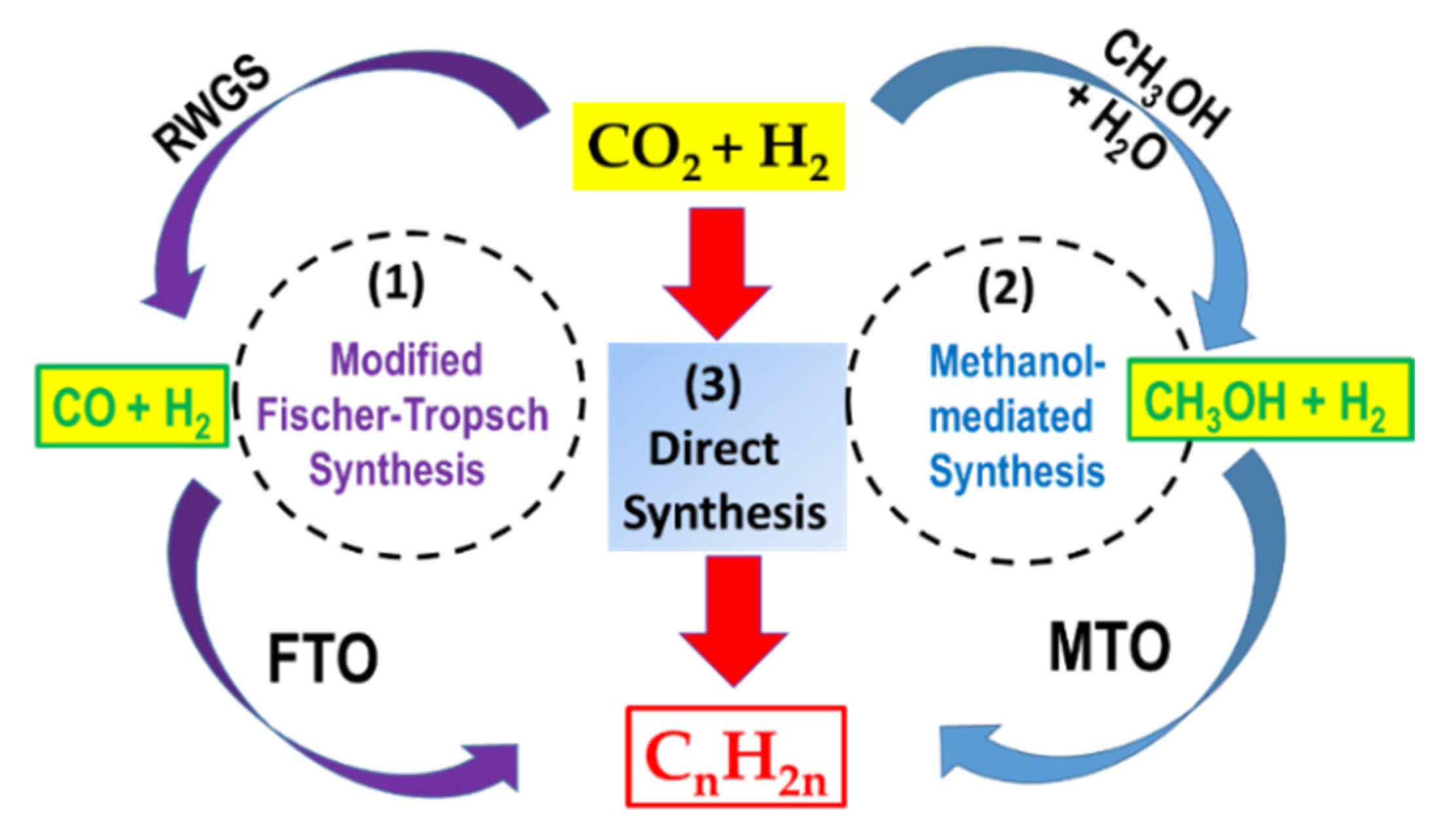
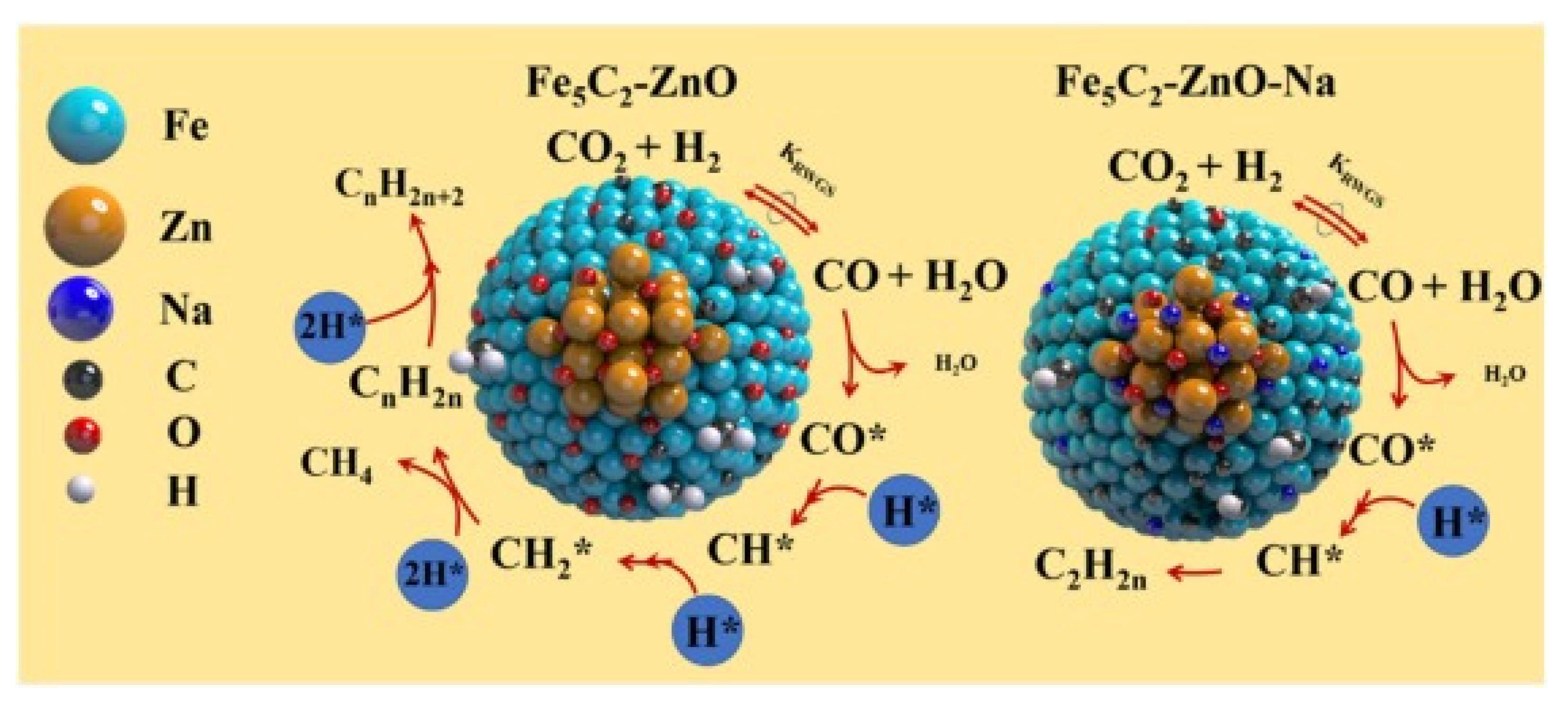
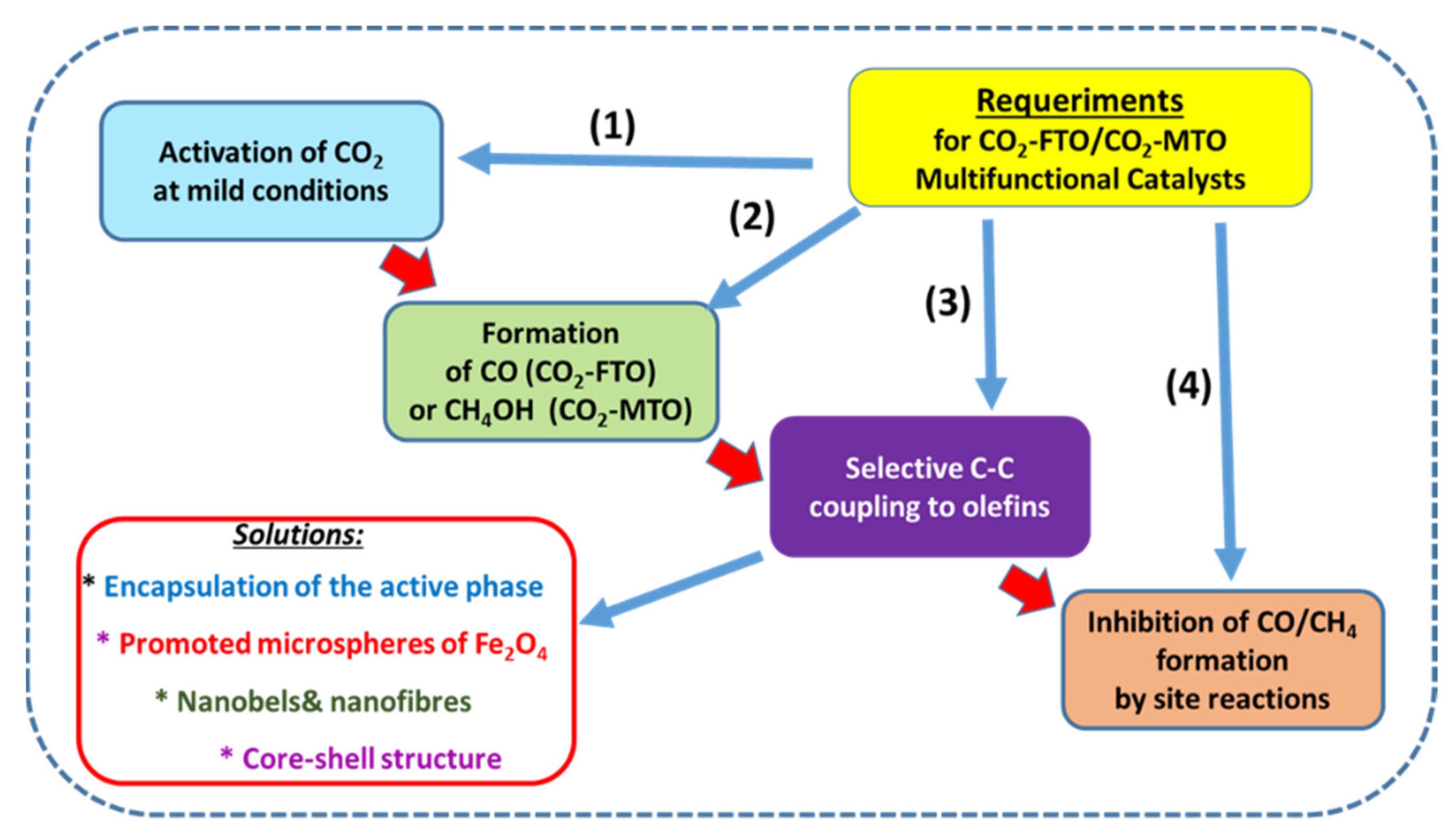
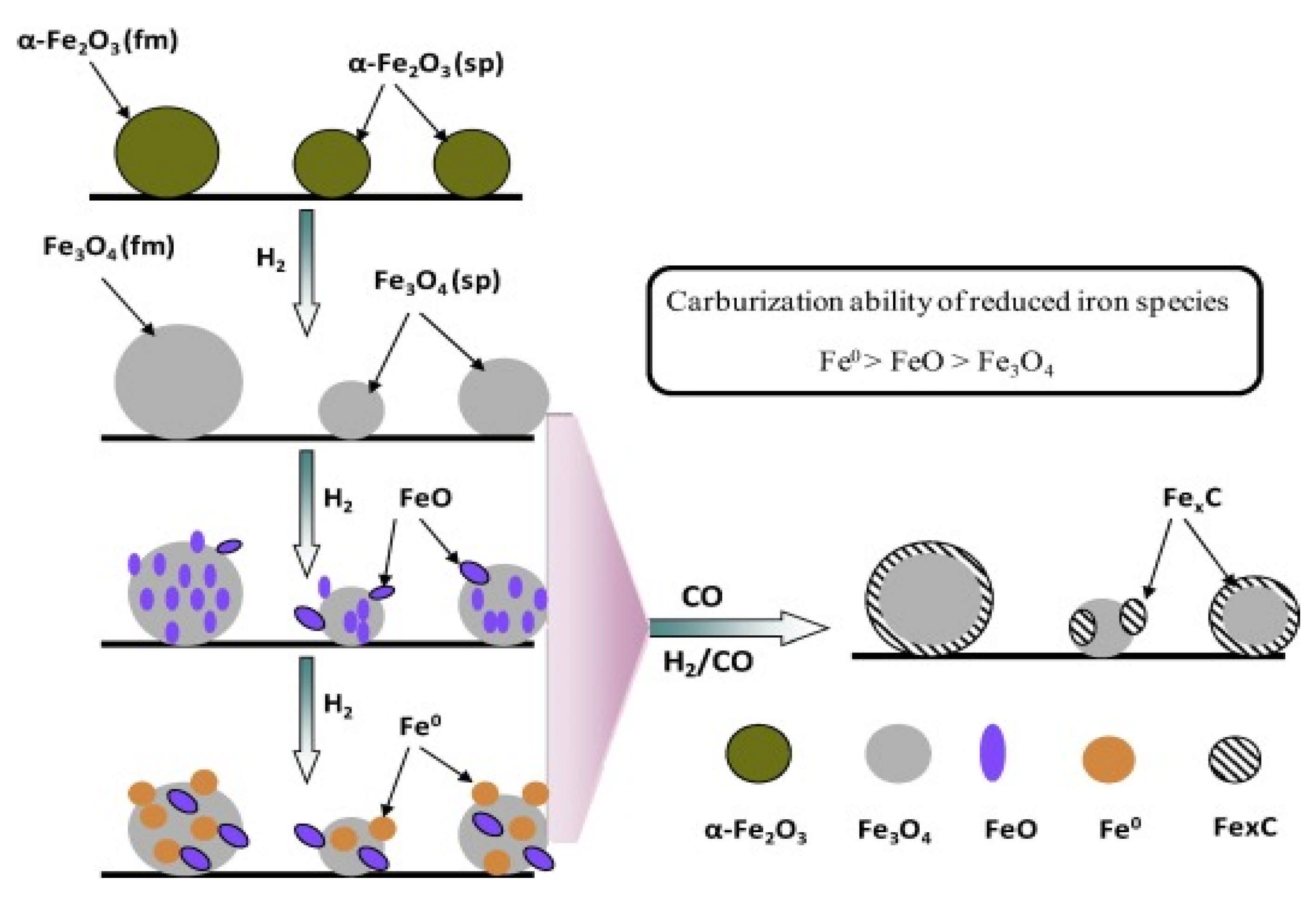

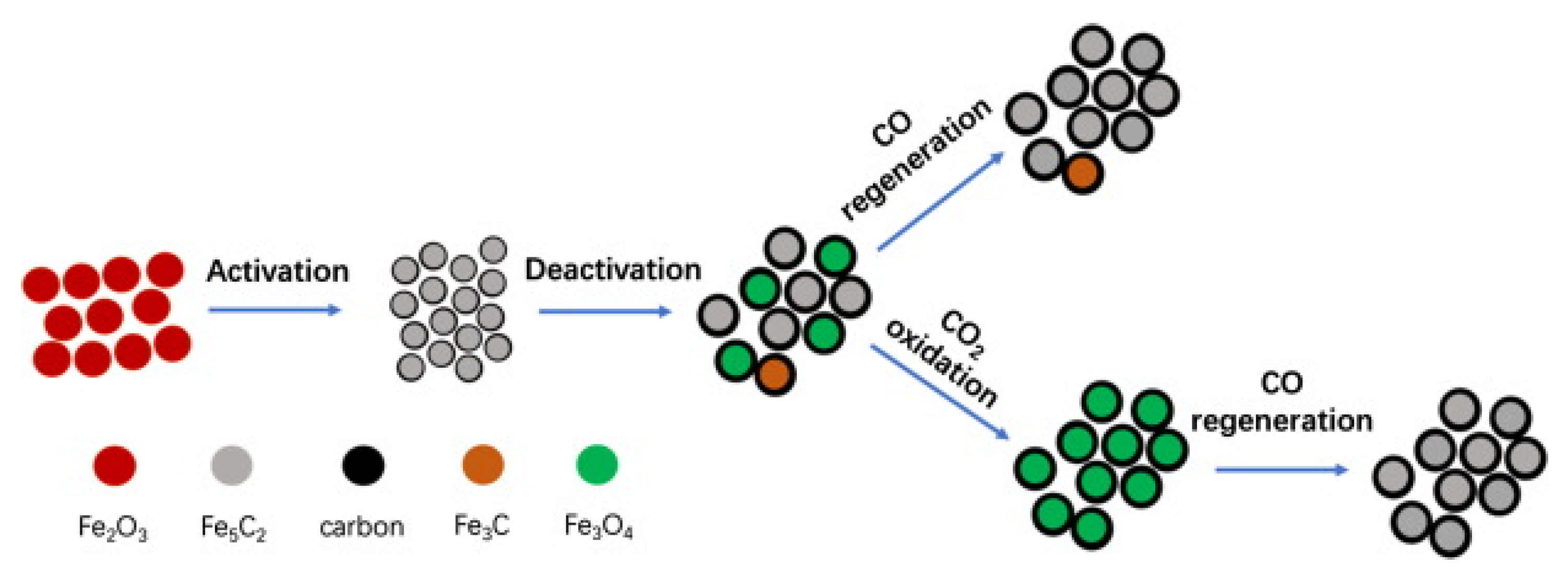

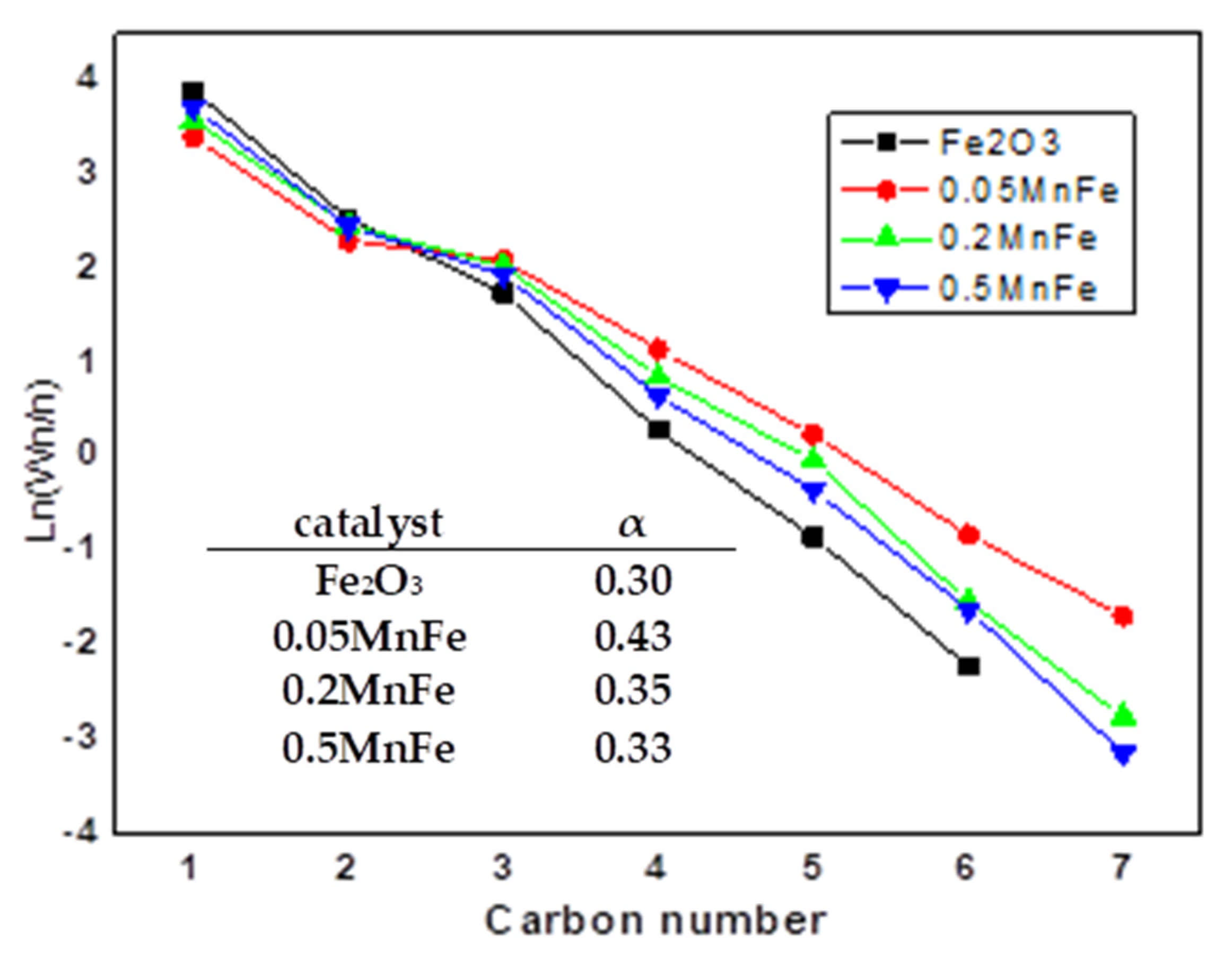
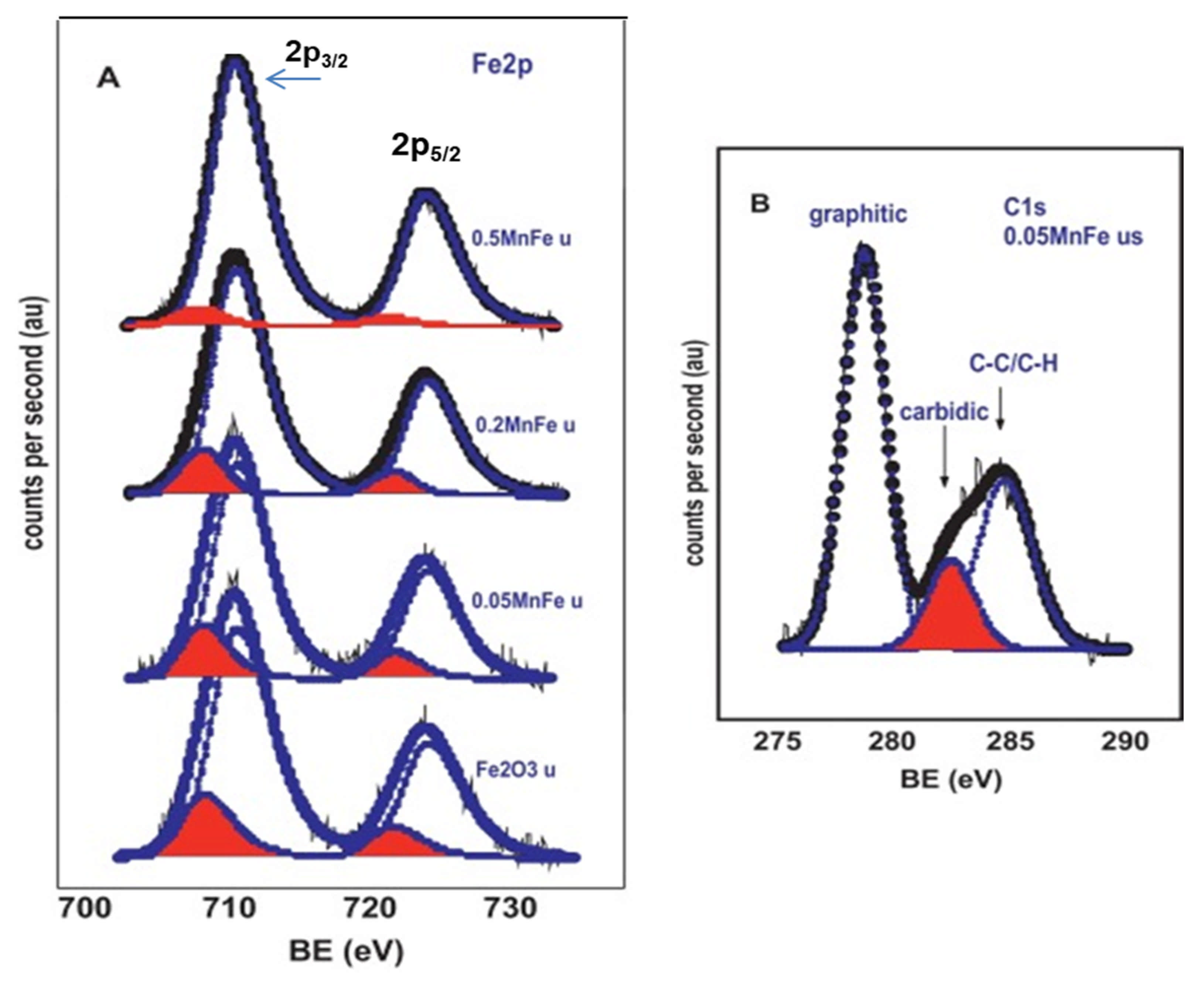
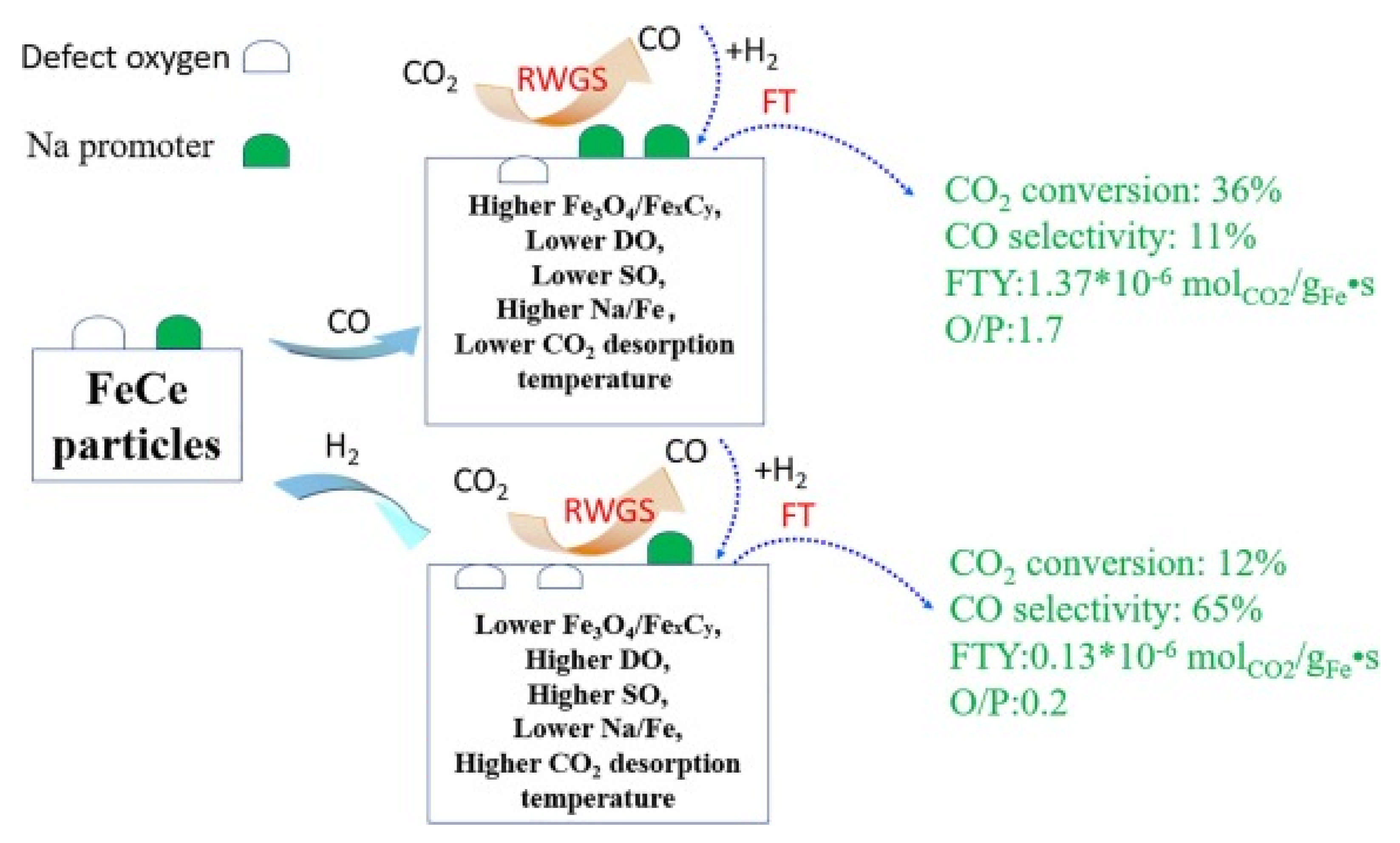
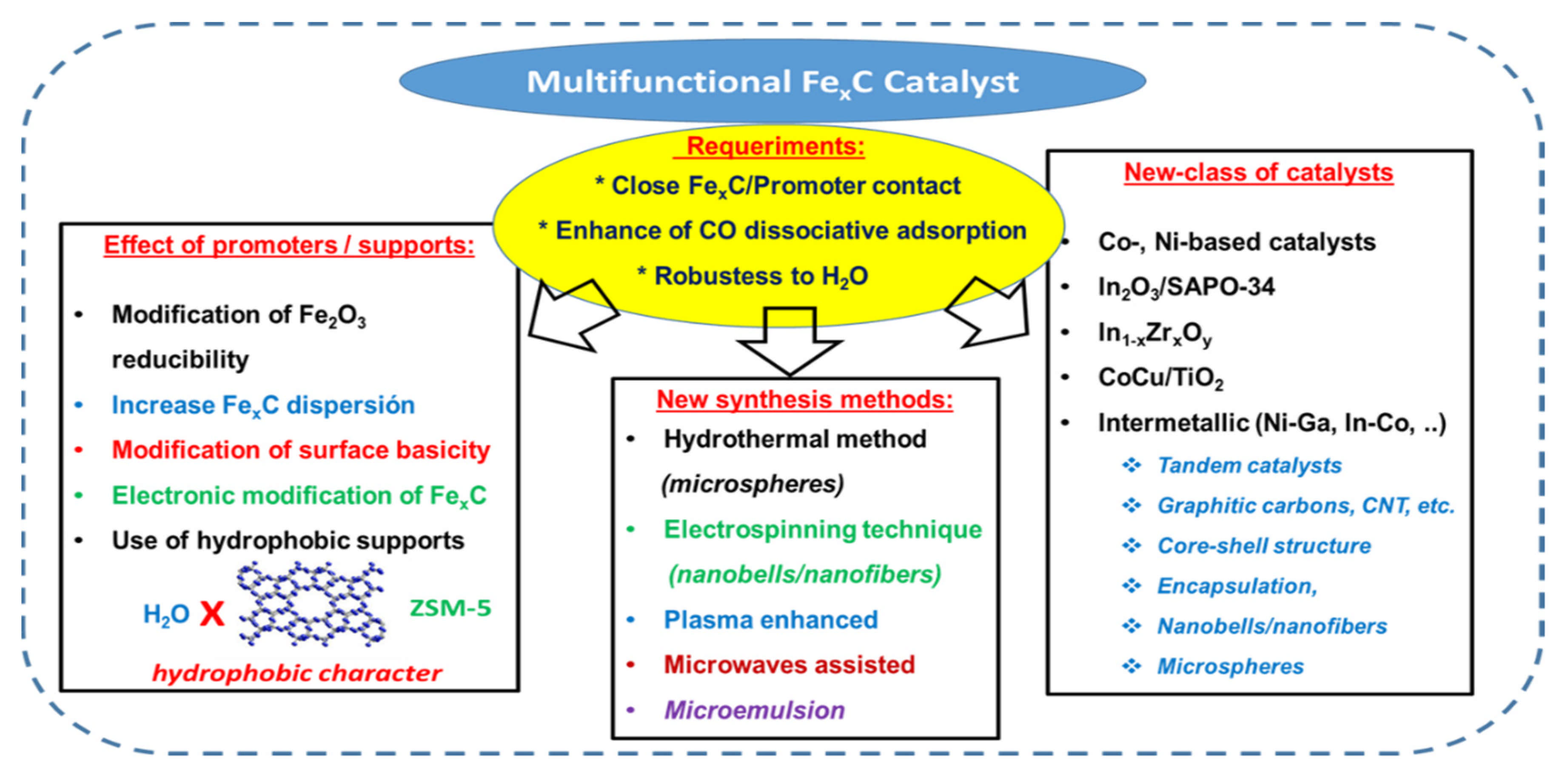


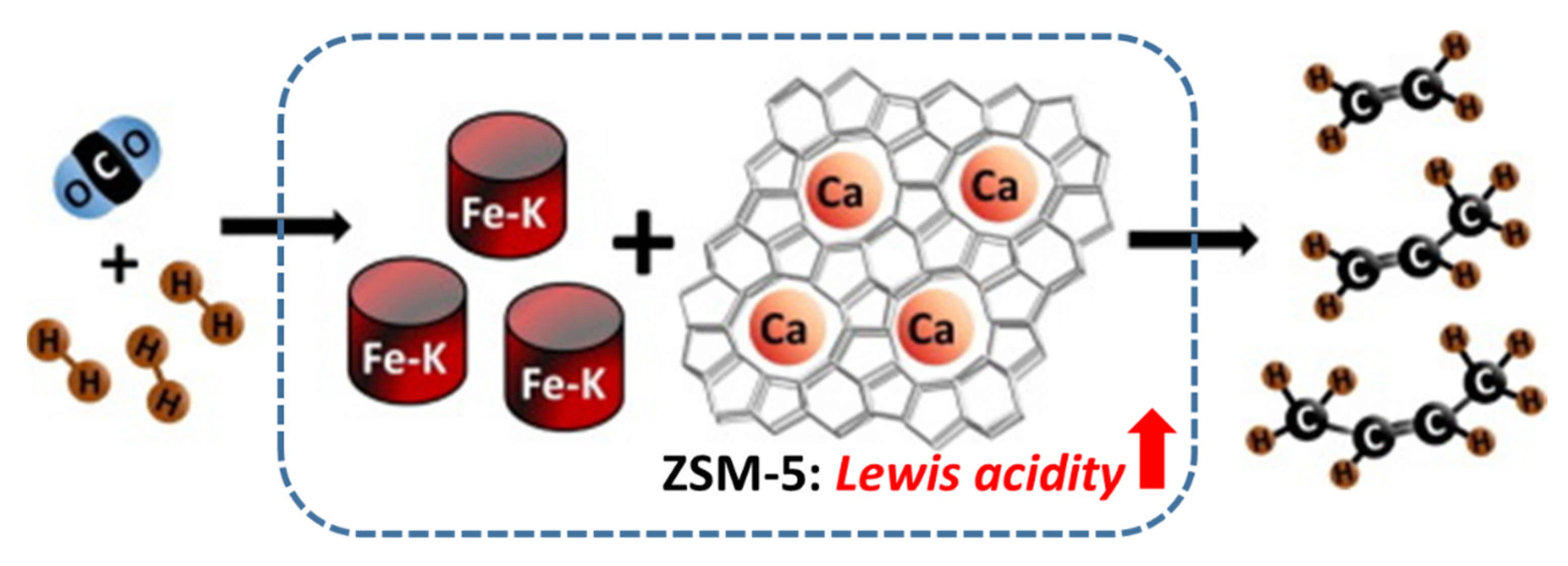
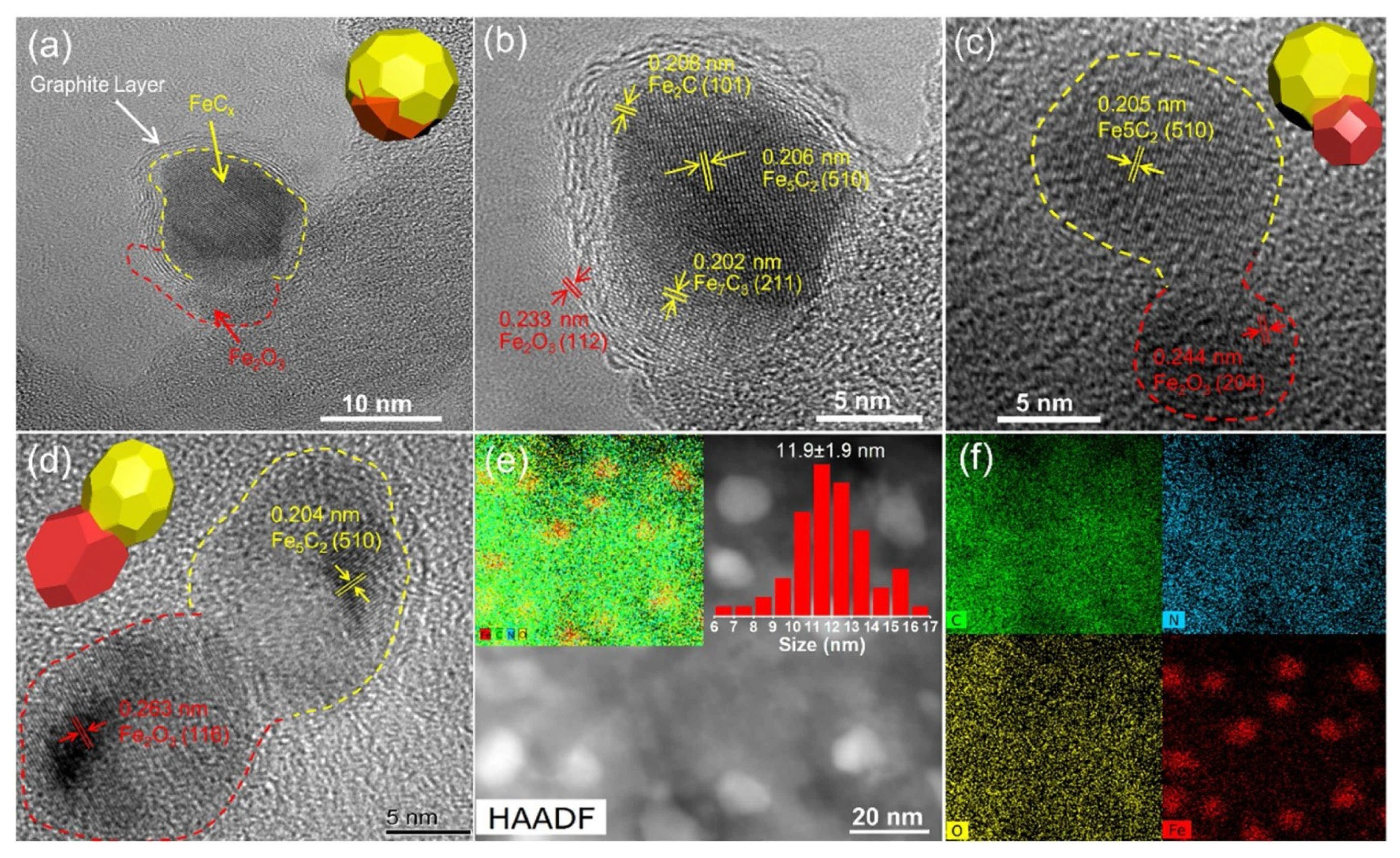
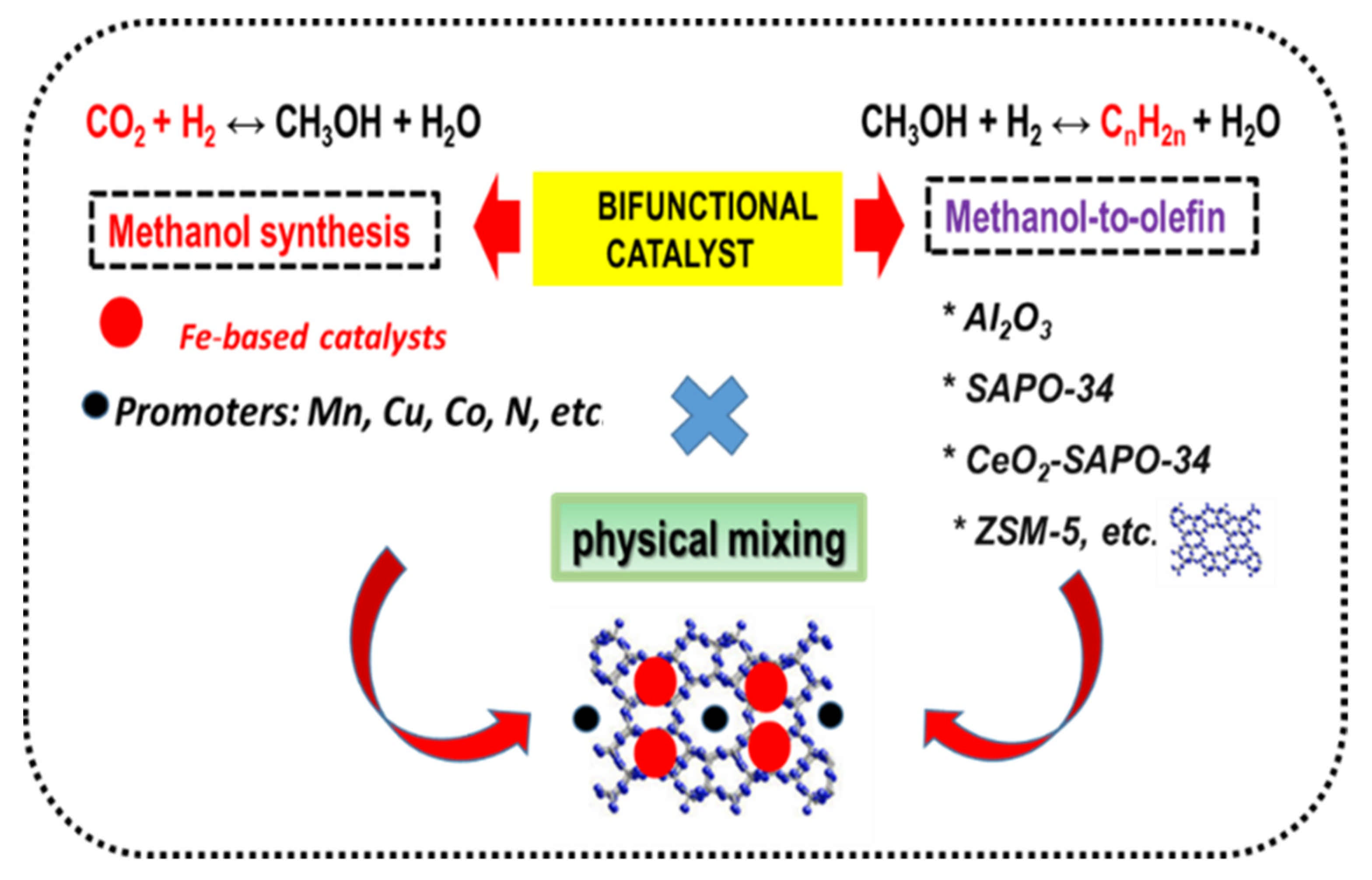
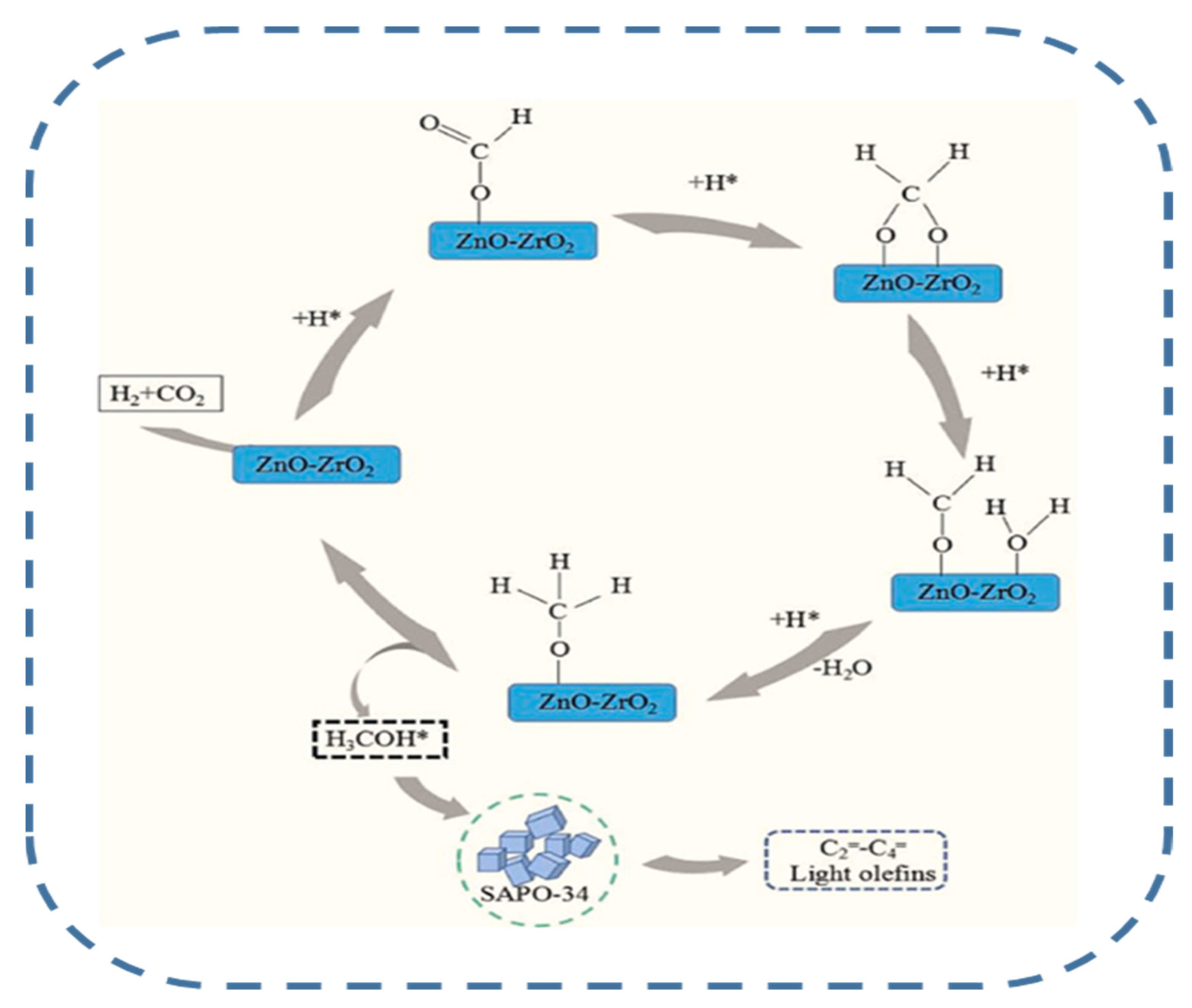
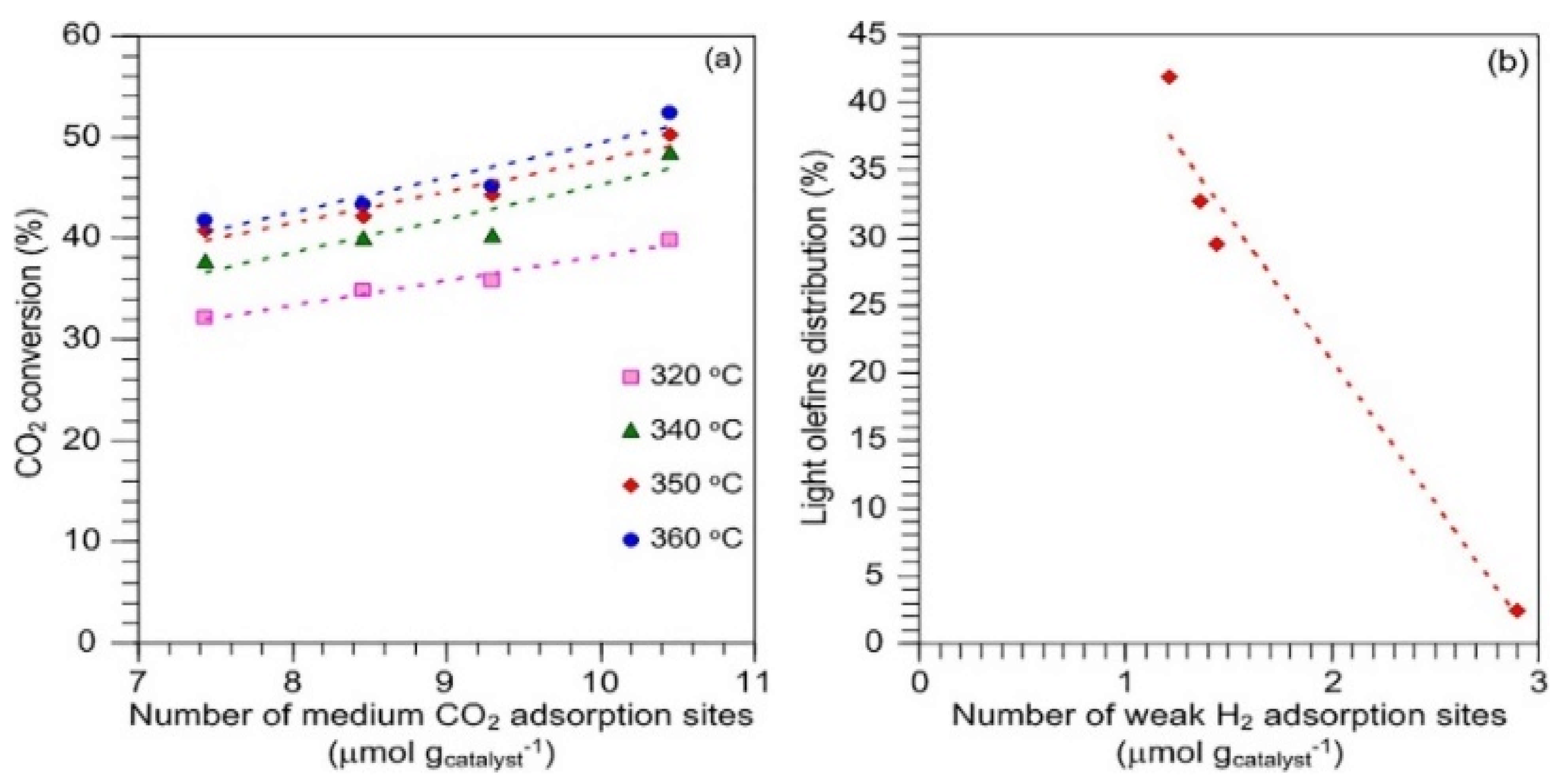

| Property | Fe | Co–Fe |
|---|---|---|
| Activity | Low CO2 conversion | Enhanced CO2 conversion |
| Requirements | Uniform dispersion of active sites and Fe(110) faces for CO2 dissociation | A very low Co content Co–Fe5C2: intimate contact |
| Selectivity C2=–C4= | χ-Fe5C2: higher selectivity than θ-Fe3C | Enhanced olefins production |
| C5+ products | Formation of alkanes | long-chain products |
| CH4 formation | High selectivity toward CH4 | Inhibition of CH4 formation |
| RWGS activity | Active | Co sites: inactive Fe sites: active |
| Active sites | χ-Fe5C2: lower hydrogenation ability and chain grown probability than θ-Fe3C: | Co sites: CO dissociation Fe5C2 sites: hydrogenation and chain growth |
| Temperature | High (570–630 K) | Low (470–530 K) |
Publisher’s Note: MDPI stays neutral with regard to jurisdictional claims in published maps and institutional affiliations. |
© 2021 by the authors. Licensee MDPI, Basel, Switzerland. This article is an open access article distributed under the terms and conditions of the Creative Commons Attribution (CC BY) license (https://creativecommons.org/licenses/by/4.0/).
Share and Cite
Pawelec, B.; Guil-López, R.; Mota, N.; Fierro, J.L.G.; Navarro Yerga, R.M. Catalysts for the Conversion of CO2 to Low Molecular Weight Olefins—A Review. Materials 2021, 14, 6952. https://doi.org/10.3390/ma14226952
Pawelec B, Guil-López R, Mota N, Fierro JLG, Navarro Yerga RM. Catalysts for the Conversion of CO2 to Low Molecular Weight Olefins—A Review. Materials. 2021; 14(22):6952. https://doi.org/10.3390/ma14226952
Chicago/Turabian StylePawelec, Barbara, Rut Guil-López, Noelia Mota, Jose Luis Garcia Fierro, and Rufino Manuel Navarro Yerga. 2021. "Catalysts for the Conversion of CO2 to Low Molecular Weight Olefins—A Review" Materials 14, no. 22: 6952. https://doi.org/10.3390/ma14226952
APA StylePawelec, B., Guil-López, R., Mota, N., Fierro, J. L. G., & Navarro Yerga, R. M. (2021). Catalysts for the Conversion of CO2 to Low Molecular Weight Olefins—A Review. Materials, 14(22), 6952. https://doi.org/10.3390/ma14226952








